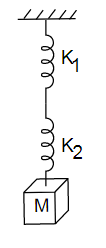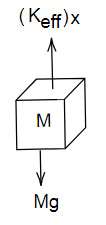
A mass M is suspended by two springs of force constants \[{K_1}\] and \[{K_2}\] respectively as shown in the diagram. The total elongation (stretch) of the two springs is

A. \[\dfrac{{Mg}}{{{K_1} + {K_2}}} \\ \]
B. \[\dfrac{{Mg\left( {{K_1} + {K_2}} \right)}}{{{K_1}{K_2}}} \\ \]
C. \[\dfrac{{Mg\left( {{K_1}{K_2}} \right)}}{{{K_1} + {K_2}}} \\ \]
D. \[\dfrac{{{K_1} + {K_2}}}{{{K_1}{K_2}Mg}}\]
Answer
221.4k+ views
Hint: Force on the system will be a product of effective constant for the series combination and elongation in the spring.
Formula used:
The expression of restoring force is,
\[F = Kx\]
Where, F = Force, k= Spring constant and x = Elongation (stretch) of the spring.
Complete step by step solution:
Given here is a spring mass system of two springs having constant \[{K_1}\] and \[{K_2}\] respectively. Springs are combined together in series combination and a mass M is suspended by the springs, we have to find the elongation in springs.
First we need to find the effective constant for the given combination of springs and it will be,
\[{K_{eff}} = \dfrac{{{K_1}{K_2}}}{{{K_1} + {K_2}}}\,.........(1)\]
Let the elongation in spring be x then free body diagram of suspended mass M will be,

Image: Free body diagram of mass M
From free body diagram we have,
\[{K_{eff}}x = Mg \\
\Rightarrow x = \dfrac{{Mg}}{{{K_{eff}}}}\,.......(2)\]
Substituting value of \[{K_{eff}}\] form equation (1) in equation (2) we get,
\[x = \dfrac{{Mg\left( {{K_1} + {K_2}} \right)}}{{{K_1}{K_2}}}\,\]
Hence, elongation in the spring will be \[\dfrac{{Mg\left( {{K_1} + {K_2}} \right)}}{{{K_1}{K_2}}}\,\].
Therefore, option B is the correct answer.
Note: Even though in combination of springs we have multiple springs connected to each other either in series or parallel, they behave like a single spring and to solve numerical problems for combination of springs their effective constant is to be calculated first.
Formula used:
The expression of restoring force is,
\[F = Kx\]
Where, F = Force, k= Spring constant and x = Elongation (stretch) of the spring.
Complete step by step solution:
Given here is a spring mass system of two springs having constant \[{K_1}\] and \[{K_2}\] respectively. Springs are combined together in series combination and a mass M is suspended by the springs, we have to find the elongation in springs.
First we need to find the effective constant for the given combination of springs and it will be,
\[{K_{eff}} = \dfrac{{{K_1}{K_2}}}{{{K_1} + {K_2}}}\,.........(1)\]
Let the elongation in spring be x then free body diagram of suspended mass M will be,

Image: Free body diagram of mass M
From free body diagram we have,
\[{K_{eff}}x = Mg \\
\Rightarrow x = \dfrac{{Mg}}{{{K_{eff}}}}\,.......(2)\]
Substituting value of \[{K_{eff}}\] form equation (1) in equation (2) we get,
\[x = \dfrac{{Mg\left( {{K_1} + {K_2}} \right)}}{{{K_1}{K_2}}}\,\]
Hence, elongation in the spring will be \[\dfrac{{Mg\left( {{K_1} + {K_2}} \right)}}{{{K_1}{K_2}}}\,\].
Therefore, option B is the correct answer.
Note: Even though in combination of springs we have multiple springs connected to each other either in series or parallel, they behave like a single spring and to solve numerical problems for combination of springs their effective constant is to be calculated first.
Recently Updated Pages
Uniform Acceleration Explained: Formula, Examples & Graphs

JEE Main 2022 (July 26th Shift 1) Physics Question Paper with Answer Key

JEE Main 2022 (June 26th Shift 2) Chemistry Question Paper with Answer Key

Apparent Frequency Explained: Formula, Uses & Examples

JEE Main 2023 (January 30th Shift 2) Chemistry Question Paper with Answer Key

JEE Main 2023 (April 15th Shift 1) Physics Question Paper with Answer Key

Trending doubts
JEE Main 2026: Application Form Open, Exam Dates, Syllabus, Eligibility & Question Papers

Derivation of Equation of Trajectory Explained for Students

Hybridisation in Chemistry – Concept, Types & Applications

Understanding the Angle of Deviation in a Prism

How to Convert a Galvanometer into an Ammeter or Voltmeter

Degree of Dissociation: Meaning, Formula, Calculation & Uses

Other Pages
JEE Advanced Marks vs Ranks 2025: Understanding Category-wise Qualifying Marks and Previous Year Cut-offs

Thermodynamics Class 11 Physics Chapter 11 CBSE Notes - 2025-26

Units And Measurements Class 11 Physics Chapter 1 CBSE Notes - 2025-26

NCERT Solutions For Class 11 Physics Chapter 8 Mechanical Properties Of Solids

Motion in a Straight Line Class 11 Physics Chapter 2 CBSE Notes - 2025-26

Laws of Motion Class 11 Physics Chapter 4 CBSE Notes - 2025-26




